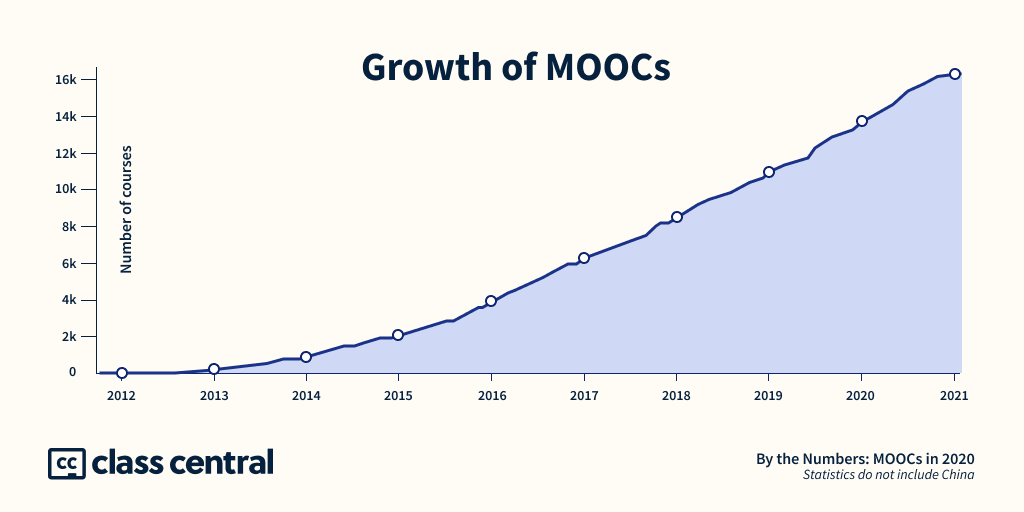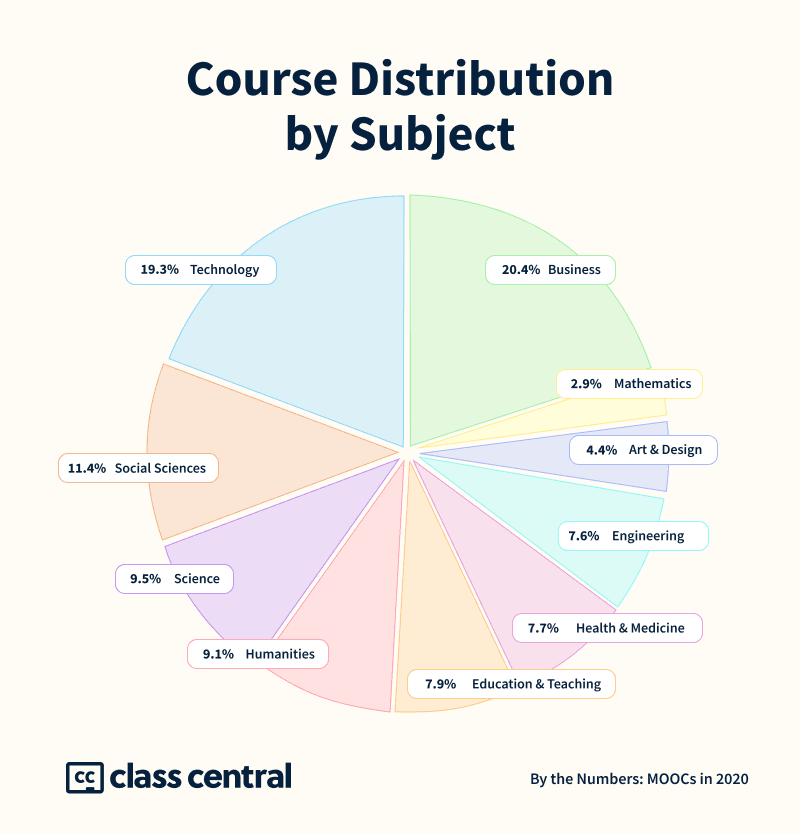By The Numbers: MOOCs in 2020
Boosted by the pandemic, MOOCs crossed 180 million learners in their ninth year.
One third of the learners that ever registered on a MOOC platform joined in 2020. The pandemic brought many people into online education. MOOC providers, in particular, benefited immensely by attracting many learners with their free online courses from top universities.
This is also true for Class Central. Out of all the people who ever used Class Central, 40% did so for the first time this year.
Now in its 9th year, the modern MOOC movement has crossed 180 million learners, excluding China1. In 2020, providers launched over 2800 courses, 19 online degrees, and 360 microcredentials.
Here’s how the top MOOC providers look in terms of users and offerings:
| Learners | Courses | Microcredentials | Degrees | |
| Coursera | 76 million | 4,6003 | 610 | 25 |
| edX | 35 million | 3,100 | 385 | 13 |
| FutureLearn2,4 | 14 million | 1,160 | 86 | 28 |
| Swayam2 | 16 million | 1,130 | 0 | 0 |
For Class Central‘s complete analysis, keep reading. For our previous years’ analyses, follow the links:
- By The Numbers: MOOCs in 2019
- By The Numbers: MOOCs in 2018
- By The Numbers: MOOCs in 2017
- By The Numbers: MOOCs in 2016
- By The Numbers: MOOCs in 2015
Courses
By the end of 2020, 16.3K MOOCs will be announced or launched by around 950 universities worldwide. In 2020 alone, around 2.8K courses were added.
Learners
In the years leading to 2020, MOOC providers’ growth had stagnated: they were gaining a similar number of learners every year.
But in 2020, providers gained over 60 million new learners combined. Half of these were just for Coursera, who gained almost as many users in a year than edX, its next closest competitor, gained since its inception.
Online Degrees
| 2017 | 2018 | 2019 | 2020 | |
| Coursera | 4 | 11 | 16 | 25 |
| edX | 1 | 9 | 10 | 13 |
| FutureLearn | 4 | 18 | 23 | 28 |
2018 was a blockbuster year for MOOC-based degrees: 30 degrees were added, leading me to call it the year of MOOC-based degrees.
But in 2019, we saw a big slowdown: only 11 degrees were announced.
This trend has seen an uptick in 2020: 19 online degrees have been announced, and edX removed its marketing master’s from Curtin University. FutureLearn also removed a degree: the Cyber Security master’s from Deakin University.
In total, there are now 67 MOOC-based degrees. This includes Georgia Tech’s online master’s degree in computer science (OMSCS), which used to be offered on Udacity, but went independent in 2020.
You can find a comprehensive list of MOOC-based master’s degrees here.
Microcredentials
| Type | Provider | 2018 | 2019 | 2020 |
| Specializations | Coursera | 310 | 400 | 569 |
| Professional Certificate | Coursera | 0 | 13 | 26 |
| MasterTrack | Coursera | 3 | 6 | 18 |
| Professional Certificate | edX | 89 | 123 | 176 |
| MicroMasters | edX | 51 | 56 | 67 |
| XSeries | edX | 29 | 40 | 40 |
| Professional Education | edX | 62 | 73 | 94 |
| MicroBachelors | edX | 0 | 0 | 8 |
| Nanodegrees | Udacity | 35 | 40 | 73 |
| Programs | FutureLearn | 23 | 32 | 36 |
| Microcredentials | FutureLearn | 0 | 0 | 32 |
| Academic Certificates4 | FutureLearn | 14 | 17 | 19 |
| Programs | Kadenze | 19 | 20 | 20 |
In 2020, 360 new microcredentials were launched — 200 of them by Coursera alone. This represents a significant increase over 2019, when 170 microcredentials were launched. In total, there are now 1180 microcredentials of 13 different types.
Subjects
Overall, the distribution of courses across subjects remains similar to last year. Forty percent of courses belong to the categories that are the easiest to monetize: business and technology.
[1] We decided to leave China out of our analysis because, as we learned more about Chinese online education, we realized that the metrics we’d like to present are: (1) sometimes unavailable, (2) sometimes available but impossible to validate to the extent we’d like, (3) sometimes reflect a view too narrow to adequately capture the overall state of MOOCs in China.
[2] For platforms with session-based courses, we counted the total number of distinct courses offered in 2020.
[3] This doesn’t include Coursera Project Network courses, since they tend to offer a light-weight learning experience compared to academic or professional Coursera courses.
[4] Graduate and postgraduate certificates are listed under microcredentials instead of under degrees.
Tags










SAK
Always appreciate the quality of these year-end round ups, thank you. Hoping that as you publish the round ups specific to each provider, you’ll be able to share what you’ve gathered on enrollment across online degree programs.
Mohammad Alshehri
I study students’ behaviours in MOOCs and I really like this annual report.
Thank you Dhawal.
Ümit Durak
Why China not include your date numbers?
Adam
they do not share.
PG
Thanks for the article, Dhaval!
How are you coming up with 180m learners? Are those unique students? Just wondering if you are adding students across the platforms, that might cause double counting because many of these students will be registered on more than one platforms. Thanks.
Yotam
Thanks for a great article.
I see you mentioned the distribution of courses by subject.
Can you tell the enrolments distribution by subject (specifically technology related)?
Trevor
Does the 180M students refer to cumulative enrollments, or enrollments in that calendar year?
Additionally, how are enrollments calculated?
Dhawal Shah
These are the total number of students based on the numbers reported by providers themselves. Enrollments will be much higher i.e a student can signup for multiple courses.
Ahmed Makharesh
I am spending nearly 6 hours in the hope to reach a certain data of how many instructors are teaching or previously taught MOOC courses? all that’s been published and shared is from the perspective of the learners? Any idea?
Jyoti B
Can we know why the enrollment statistics of Udacity are not available for the year 2020 and 2021. Since we are trying to analyse the enrollments prior and post pandemic period.
Greg Dunkling
How did you verify these numbers?
Dhawal Shah
Since we catalog courses throughout the year (and doing this for a decade), we have a fairly accurate history of when a course was launched.